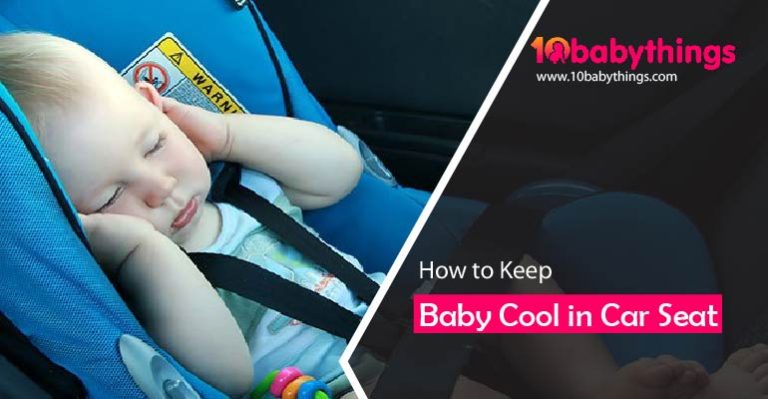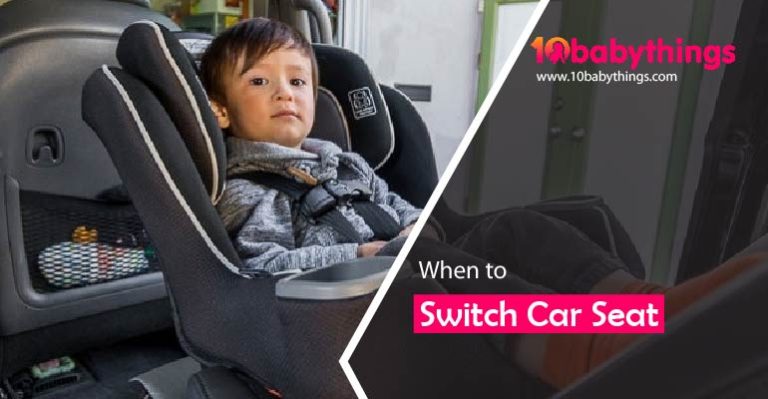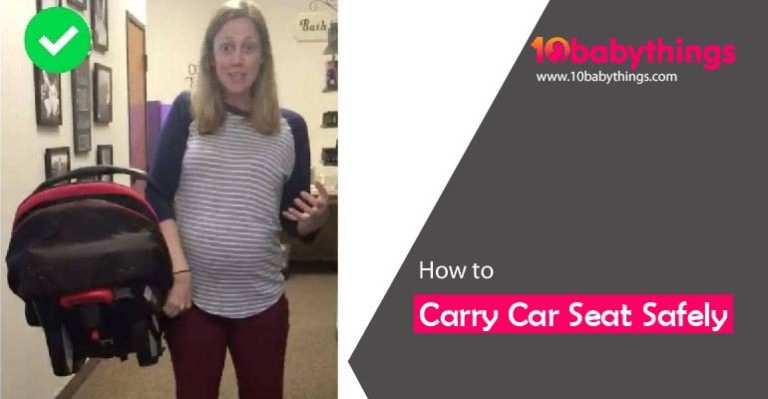When Can Baby Face Forward In Their Car Seat?
Children up to 40 to 50 pounds can use convertible car seats rear-facing, usually in the rear-facing position. As soon as the car seat is converted, it will become forward-facing.
The first time you put your newborn into a car seat is a great feeling, but do you know how it feels when you bring them home from the hospital? Wow, that must have been nerve-wracking!
Can you tell if the straps are tight enough? What is the correct adjustment for the harness? How fast should I drive? Should I drive like a sloth?
Your baby’s car seat safety becomes a top priority once he or she leaves the hospital. Toddlers might wonder whether they can switch from a rear-facing seat to a forward-facing seat when they are older. The height and weight of the child play a role in the answer.
Let’s talk about when it’s safe to switch your baby to a forward-facing car seat, why you shouldn’t make the switch too soon, and any safety precautions to take.
What Makes a Rear-Facing Seat the Best?
It is important for parents to understand what happens to children in an accident before they can decide whether to keep them in a rear-facing seat. In the event of a car crash at about 30 mph.
It is relatively slow. In addition, Dr. Hoffman says it is capable of throwing a 10-pound child nearly 450 pounds of momentum. Compared to a 10-pound bowling ball dropped from a third-story window, that’s about 40% more momentum.
There is a lot of force that needs to be dealt with, and we need to make sure it’s done in a way that protects the person”, Hoffman explains.”
It is important to remember that car seats spread that force over the largest amount of area possible in order to protect kids. When a child is pushed into a rear-facing seat in a crash, the entire force of the crash is distributed head to toe.”
Compared with rear-facing car seats, front-facing car seats have a much less protective surface area, such as a five-point harness. In addition, a rear-facing seat does not provide adequate protection for a baby’s “enormous wiggly-woggly head”.
As a result of being thrown forward in a crash, an adult’s head and neck could suffer injury. For a child, however, the head would be thrown forward with much more force than an adult’s head. There is a high risk that they will suffer a catastrophic head, neck, or spinal injury.
As a result of its design, a rear-facing car seat can help prevent injuries to your baby’s head, neck, spine, and body during impacts. Therefore, rear-facing seats are safer for your child for as long as possible.
Car Seats for Rear-Facing Children
Have you ever wondered when the best time is to switch from a backward to a forward-facing position? You will have to choose a car seat based on your needs. It is up to the manufacturers to determine whether your child should ride rear-facing or forward-facing, based on the weight and length limits for their seats. (This information isn’t based on age.)
Parents can also choose a rear-facing seat based on weight and length limits. In addition to rear-facing car seats, convertible seats can also face backward, according to Dr. Hoffman. The safety of both types of car seats is the same, Dr. Hoffman points out, but what separates them is the convenience.
Rear-facing-only seats
According to Dr. Hoffman, rear-facing car seats are normally rated for maximum weights of about 30 pounds and maximum lengths of about 30 inches.
The reason why they are popular with parents is that they are easily removable from the car seat base and can be quickly reattached to a stroller base, making transferring your baby in and out of the vehicle a much more convenient process.
What are the downsides? When your baby reaches the weight or height limits, you’ll need to purchase a new infant car seat. Parents in all 50 states can qualify for free, new, safe car seats through programs. If you’d like more information, you can contact your local hospital or WIC program.
Seats that can be converted
A convertible car seat, on the other hand, starts out rear-facing and can be converted to forward-facing as your child grows.
There is a limit of 40 pounds for most rear-facing convertible seats, and a maximum length of more than 40 inches in order for the seat to remain facing backward, according to Dr. Hoffman. As a result, they are usually able to remain rear-facing for a longer period of time.
Unfortunately, these car seats do not detach from their bases in the car and are typically heavy and bulky. In addition to being more expensive, they last much longer than infant car seats that are only rear-facing.
Do Car Seats Allow Babies to Face Forward?
All infants should be rear-facing until their car seat manufacturers allow them to reach the maximum weight or height limit. Rear-facing convertible seats are usually limited to 2 years or more for children.
Guidelines for car seats
Depending on the model, rear-facing car seats are used for infants weighing 22 to 35 pounds and measuring 26 to 35 inches.
Car seats that transform from rear-facing to forward-facing are convertible car seats with higher weight limits.
Rear-facing car seats (up to 40 or 50 pounds), forward-facing car seats, or belt-positioning boosters: Can be used rear-facing, forward-facing, or even as a belt-positioner.
Regardless of your child’s age, don’t switch to a forward-facing car seat for the wrong reasons. The days of rear-facing-only car seats aren’t over just because a child has grown out of them!
Your child can remain rear-facing until they reach 40 or 50 pounds with many convertible seats on the market.
“You shouldn’t put your 2, 3, 4, or 5-year-old in the front seat in a car, which is why you should put them in the back seat,” says Florencia Segura, MD, FAAP.
Furthermore, if a child’s feet are touching the back seat, many parents will switch to forward-facing. Even if a child’s legs appear scrunched, their leg length does not affect how long they can remain rear-facing, says Dr. Segura.
Dr. Garbi adds, “This isn’t a big concern from a safety standpoint, and most people are comfortable with them because they are so flexible.”
Talk to your pediatrician if you are unsure which car seat to choose (there are many on the market!). Their expertise can help you choose the best car seat for your child.
The Benefits of Not Sitting Forward-Facing Too Early
Rear-facing car seats are more effective in protecting young children, especially those two and under, from severe injuries, according to Lyndsey Garbi, MD, chief of pediatrics at Blueberry Pediatrics.
Dr. Segura agrees, adding, “Studies consistently show that kids who ride rear-facing sustain fewer injuries than those who ride forward-facing.”
Severe injuries are more likely to occur
SAE International published a study in 2018 that found rear-facing car seats reduce infant and toddler deaths and injuries in the frontal, side, and rear-impact accidents significantly.
The study aimed to determine whether children were truly safer even when facing the direction of the collision because rear-impact collisions account for over 25 percent of all accidents.
In a study conducted at OSU’s Injury Biomechanics Research Center, researchers and engineers found that rear-facing children suffered fewer severe injuries during rear-end collisions even if they were rear-facing.
As the child sits in the back of the car seat, the head, neck, and spine are supported as well as the vulnerable parts of the body are protected from crash forces.
Each child is built differently
It is important to remember that children aren’t just little adults, as Dr. Segura emphasizes. Due to their different proportions and structures, their bodies are less able to tolerate whiplash motion.”
Baby’s heads make up 25 percent of their bodies, while adults’ heads make up only 6 percent. According to her, rear-facing babies slide up into their car seats gently rather than pushing forward with 4x as much force as adults.
Injuries to the spine and neck
The rear-facing car seat is particularly effective at protecting the spine, which reduces injuries to the neck and spinal cord. In addition, when a child sits rear-facing, their head, neck, and torso all move together in a straight line, reducing the possibility of whiplash injuries.
A child’s disproportionately large head may suffer severe injuries to the neck or spine when it is prematurely thrown forward during a crash.
Aspects of Safety
It is important to keep some safety precautions in mind when turning your child’s car seat forward-facing.
Inspect the car seat for proper installation
Don’t forget to strap your forward-facing car seat properly when you put your child in. The most important safety features, according to Dr. Garbi, are to ensure the seat belt is tightly fastened to the car, that the straps are tight on the shoulders, and that the buckles and clips are properly positioned.
Ensure that the tether is always secured in forward-facing seats. Tethers secure the top of car seats to anchors in the back of the vehicle. Up to eight inches are saved if the top of the seat is tightened during a collision.
Don’t let your child sit in the front
Children should always sit in the back seat of a car until they are 13 years old, regardless of whether they are forward-facing or in a booster seat. Originally designed for adults, passenger seat airbags are a great danger for small children. It is possible to suffer significant injuries to the head and neck from a deploying airbag (around 200 mph).
The safest seat in the back is in the middle
In order to prevent direct impact from a collision, children should sit in the middle seat of the back. If you have one rear-facing child and another forward-facing child, the forward-facing child should be in the middle, since they are less protected.
Conclusion:
You should always ask for help if you have any questions about your child’s car seat. Car seat safety is so much better when you’re safe than sorry.
Despite the fact that it is much easier today than it was 20 years ago, Dr. Hoffman says it is still really difficult. Taking your kid to a doctor isn’t a crime. It’s about their safety.

![Ultimate Guide to Car Seat Safety [ Tips & Law ]](https://www.10babythings.com/wp-content/uploads/2022/09/Ultimate-Guide-to-Car-Seat-Safety-01-768x399.jpg)




